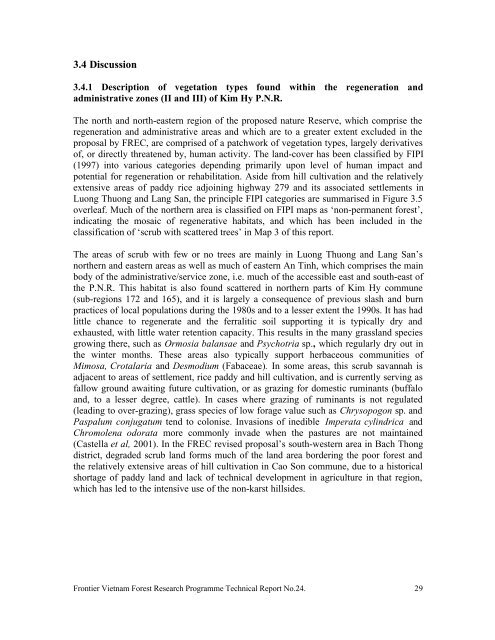Kim Hy Proposed Nature Reserve - Frontier-publications.co.uk
Kim Hy Proposed Nature Reserve - Frontier-publications.co.uk
Kim Hy Proposed Nature Reserve - Frontier-publications.co.uk
Create successful ePaper yourself
Turn your PDF publications into a flip-book with our unique Google optimized e-Paper software.
3.4 Discussion<br />
3.4.1 Description of vegetation types found within the regeneration and<br />
administrative zones (II and III) of <strong>Kim</strong> <strong>Hy</strong> P.N.R.<br />
The north and north-eastern region of the proposed nature <strong>Reserve</strong>, which <strong>co</strong>mprise the<br />
regeneration and administrative areas and which are to a greater extent excluded in the<br />
proposal by FREC, are <strong>co</strong>mprised of a patchwork of vegetation types, largely derivatives<br />
of, or directly threatened by, human activity. The land-<strong>co</strong>ver has been classified by FIPI<br />
(1997) into various categories depending primarily upon level of human impact and<br />
potential for regeneration or rehabilitation. Aside from hill cultivation and the relatively<br />
extensive areas of paddy rice adjoining highway 279 and its associated settlements in<br />
Luong Thuong and Lang San, the principle FIPI categories are summarised in Figure 3.5<br />
overleaf. Much of the northern area is classified on FIPI maps as ‘non-permanent forest’,<br />
indicating the mosaic of regenerative habitats, and which has been included in the<br />
classification of ‘scrub with scattered trees’ in Map 3 of this report.<br />
The areas of scrub with few or no trees are mainly in Luong Thuong and Lang San’s<br />
northern and eastern areas as well as much of eastern An Tinh, which <strong>co</strong>mprises the main<br />
body of the administrative/service zone, i.e. much of the accessible east and south-east of<br />
the P.N.R. This habitat is also found scattered in northern parts of <strong>Kim</strong> <strong>Hy</strong> <strong>co</strong>mmune<br />
(sub-regions 172 and 165), and it is largely a <strong>co</strong>nsequence of previous slash and burn<br />
practices of local populations during the 1980s and to a lesser extent the 1990s. It has had<br />
little chance to regenerate and the ferralitic soil supporting it is typically dry and<br />
exhausted, with little water retention capacity. This results in the many grassland species<br />
growing there, such as Ormosia balansae and Psychotria sp., which regularly dry out in<br />
the winter months. These areas also typically support herbaceous <strong>co</strong>mmunities of<br />
Mimosa, Crotalaria and Desmodium (Fabaceae). In some areas, this scrub savannah is<br />
adjacent to areas of settlement, rice paddy and hill cultivation, and is currently serving as<br />
fallow ground awaiting future cultivation, or as grazing for domestic ruminants (buffalo<br />
and, to a lesser degree, cattle). In cases where grazing of ruminants is not regulated<br />
(leading to over-grazing), grass species of low forage value such as Chrysopogon sp. and<br />
Paspalum <strong>co</strong>njugatum tend to <strong>co</strong>lonise. Invasions of inedible Imperata cylindrica and<br />
Chromolena odorata more <strong>co</strong>mmonly invade when the pastures are not maintained<br />
(Castella et al, 2001). In the FREC revised proposal’s south-western area in Bach Thong<br />
district, degraded scrub land forms much of the land area bordering the poor forest and<br />
the relatively extensive areas of hill cultivation in Cao Son <strong>co</strong>mmune, due to a historical<br />
shortage of paddy land and lack of technical development in agriculture in that region,<br />
which has led to the intensive use of the non-karst hillsides.<br />
<strong>Frontier</strong> Vietnam Forest Research Programme Technical Report No.24. 29
















